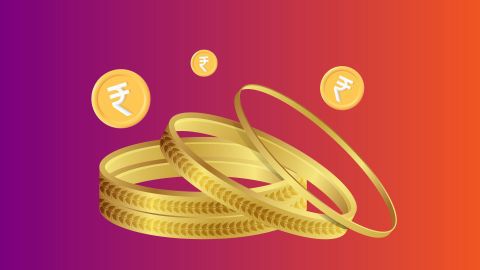3 mins
20 July 2024
Gold is a precious metal valued for its rarity, beauty, and cultural significance, often symbolising prosperity. The best days to buy gold are influenced by cultural and astrological beliefs. In India, festivals like Akshaya Tritiya, Dhanteras, and Diwali are considered auspicious for gold purchases, believed to bring good luck and prosperity. Additionally, buying gold during times of economic stability or when prices are lower can be beneficial.
Examples of making charges calculations
Let's consider two examples to illustrate the calculation of making charges for gold jewellery in the Indian context. Suppose the current market price of gold is ₹4,000 per gram. For a necklace weighing 20 grams with a making charge of 10%, the base value of the gold is ₹4,000 multiplied by 20, equalling ₹80,000. The making charge would be 10% of ₹80,000, which is ₹8,000. Therefore, the total cost of the necklace would be ₹88,000, excluding any taxes.
In another example, if a pair of earrings weighs 15 grams and the making charge is ₹500 per gram, the base value is ₹4,000 multiplied by 15, equalling ₹60,000. The making charge would be ₹500 multiplied by 15, which is ₹7,500. Thus, the total cost of the earrings would be ₹67,500, excluding any taxes. These examples highlight the different methods of calculating making charges, whether percentage-based or fixed per gram.
Additionally, regional differences and the reputation of the jeweller can impact the making charges, as jewellers in different locations or those with a prestigious brand may charge more. Market conditions, such as fluctuations in gold prices and demand, can also affect the final calculation. Understanding these factors helps in providing accurate and fair pricing for gold jewellery.
Start by calculating the base value of the gold, then add the making charges, which can be a percentage of the base value or a fixed amount per gram. This combined value gives the total worth of the jewellery, which is used to determine the loan amount. Ensuring that the making charges are correctly calculated and transparently documented can influence the appraisal process positively, leading to a more favourable loan offer.
Additionally, lenders may consider the overall quality and condition of the jewellery, so maintaining detailed records of the making charges and craftsmanship can support your application. Accurate appraisal ensures that you receive a fair loan amount based on the true value of your gold jewellery.
In another example, if a pair of earrings weighs 15 grams and the making charge is ₹500 per gram, the base value is ₹4,000 multiplied by 15, equalling ₹60,000. The making charge would be ₹500 multiplied by 15, which is ₹7,500. Thus, the total cost of the earrings would be ₹67,500, excluding any taxes. These examples highlight the different methods of calculating making charges, whether percentage-based or fixed per gram.
Tools and resources for calculating making charges
Various tools and resources are available to simplify the calculation of making charges for gold jewellery. Online calculators are widely used, allowing you to input the weight of the gold, the current market price, and the making charge percentage or fixed amount to quickly determine the total cost. Additionally, mobile apps specifically designed for jewellers offer comprehensive features, including real-time gold prices, making charge calculators, and tax inclusion options. Spreadsheets can also be an effective tool, enabling custom formulas to calculate costs accurately. Furthermore, jewellers often refer to industry-standard pricing guides and catalogues that provide benchmarks for making charges based on the type and complexity of the jewellery. These tools and resources ensure precision and efficiency in the calculation process, helping both jewellers and customers make informed decisions.Tips for accurate calculation of making charges
Accuracy in calculating making charges is crucial for both jewellers and customers. Firstly, always verify the current market price of gold from a reliable source to ensure the base value is correct. Use precise weighing scales to measure the gold accurately, as even small discrepancies can significantly impact the final cost. When applying the making charge, be clear whether it is a percentage of the base value or a fixed amount per gram. Double-check your calculations to avoid errors and consider using digital tools or calculators for enhanced accuracy. Additionally, factor in any additional costs such as taxes, hallmarking charges, or other fees that may apply. Maintaining transparency throughout the calculation process builds trust with customers and ensures fair pricing. Regularly update your knowledge of industry standards and market trends to stay competitive and provide accurate quotations.Factors affecting to calculate making charges on gold jewellery
Several factors influence the calculation of making charges on gold jewellery. The complexity and intricacy of the design play a significant role; more detailed and labour-intensive designs typically incur higher making charges. The type of craftsmanship required, such as handcrafting versus machine manufacturing, also affects the cost, with handcrafted items generally being more expensive. The purity of the gold is another factor; higher karat gold might have different making charges compared to lower karat gold due to variations in handling and processing.Additionally, regional differences and the reputation of the jeweller can impact the making charges, as jewellers in different locations or those with a prestigious brand may charge more. Market conditions, such as fluctuations in gold prices and demand, can also affect the final calculation. Understanding these factors helps in providing accurate and fair pricing for gold jewellery.
Calculating loan amounts based on gold jewellery value
When seeking a loan against gold jewellery in India, understanding how to calculate the loan amount is crucial. The value of the gold jewellery is determined by its weight and the current market price of gold. Start by weighing the jewellery to find its weight in grams. Multiply this weight by the prevailing market price per gram to get the base value of the gold. Lenders typically offer a loan amount that is a percentage of this base value, known as the loan-to-value (LTV) ratio. For example, if the LTV ratio is 75% and the base value of the jewellery is ₹1,00,000, the loan amount would be ₹75,000. It's important to compare gold loan rates offered by different lenders, as these rates can vary. Understanding these calculations helps you estimate the loan amount you might be eligible for based on your gold jewellery's value.Using calculated making charges for loan appraisals
In the context of loan appraisals for gold jewellery, accurately calculated making charges are essential. Lenders assess the total value of the jewellery, which includes both the base value of the gold and the making charges.Start by calculating the base value of the gold, then add the making charges, which can be a percentage of the base value or a fixed amount per gram. This combined value gives the total worth of the jewellery, which is used to determine the loan amount. Ensuring that the making charges are correctly calculated and transparently documented can influence the appraisal process positively, leading to a more favourable loan offer.
Additionally, lenders may consider the overall quality and condition of the jewellery, so maintaining detailed records of the making charges and craftsmanship can support your application. Accurate appraisal ensures that you receive a fair loan amount based on the true value of your gold jewellery.
Frequently asked questions
How are making charges on gold calculated?
Making charges on gold are calculated by either a fixed amount per gram or a percentage of the gold's value. First, determine the current market price of gold and the weight of the jewellery. Multiply the weight by the market price to find the base value. If using a percentage, multiply this base value by the making charge percentage. If using a fixed rate, multiply the weight by the fixed charge per gram. Add this to the base value for the total cost.
What should I consider when calculating making charges on gold for a loan?
When calculating making charges on gold for a loan, consider the current market price of gold, the weight and purity of the gold jewellery, and the making charges, which could be a percentage of the base value or a fixed amount per gram. Include any additional costs such as hallmarking fees or taxes. Accurate documentation of these details ensures a fair appraisal, enhancing the likelihood of receiving a favourable loan amount based on the true value of your gold jewellery.
What is the formula for gold making charges calculator?
The formula for calculating gold making charges is straightforward. First, determine the base value by multiplying the weight of the gold (in grams) by the current market price per gram. Next, calculate the making charge, which can be either a fixed amount per gram or a percentage of the base value. Finally, add the making charge to the base value to get the total cost. The formula is:
Total Cost = (Weight x Market Price) + Making Charge.
Total Cost = (Weight x Market Price) + Making Charge.
What are making charges on gold?
Making charges on gold refer to the cost associated with crafting gold jewellery. This fee covers the labour and expertise required to design and produce the item. Making charges can be calculated as a percentage of the gold's base value or as a fixed amount per gram. These charges vary depending on the complexity of the design, the type of craftsmanship involved, and the jeweller's pricing policies. Understanding making charges is essential for determining the final cost of gold jewellery.
Show More
Show Less
Bajaj Finserv App for All Your Financial Needs and Goals
Trusted by 50 million+ customers in India, Bajaj Finserv App is a one-stop solution for all your financial needs and goals.
You can use the Bajaj Finserv App to:
Apply for loans online, such as Instant Personal Loan, Home Loan, Business Loan, Gold Loan, and more.
You can use the Bajaj Finserv App to:
Apply for loans online, such as Instant Personal Loan, Home Loan, Business Loan, Gold Loan, and more.
- Explore and apply for co-branded credit cards online.
- Invest in fixed deposits and mutual funds on the app.
- Choose from multiple insurance for your health, motor and even pocket insurance, from various insurance providers.
- Pay and manage your bills and recharges using the BBPS platform. Use Bajaj Pay and Bajaj Wallet for quick and simple money transfers and transactions.
- Apply for Insta EMI Card and get a pre-approved limit on the app. Explore over 1 million products on the app that can be purchased from a partner store on Easy EMIs.
- Shop from over 100+ brand partners that offer a diverse range of products and services.
- Use specialised tools like EMI calculators, SIP Calculators
- Check your credit score, download loan statements, and even get quick customer support—all on the app.






